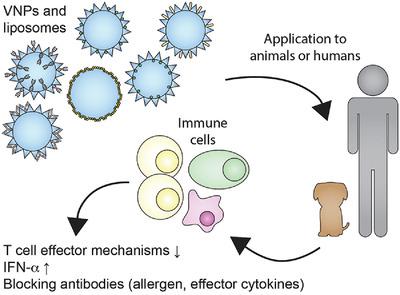当前位置:
X-MOL 学术
›
Eur. J. Immunol.
›
论文详情
Our official English website, www.x-mol.net, welcomes your feedback! (Note: you will need to create a separate account there.)
All the small things: How virus-like particles and liposomes modulate allergic immune responses.
European Journal of Immunology ( IF 5.4 ) Pub Date : 2019-12-15 , DOI: 10.1002/eji.201847810 Bernhard Kratzer 1 , Sandra Hofer 1 , Maja Zabel 1 , Winfried F Pickl 1
European Journal of Immunology ( IF 5.4 ) Pub Date : 2019-12-15 , DOI: 10.1002/eji.201847810 Bernhard Kratzer 1 , Sandra Hofer 1 , Maja Zabel 1 , Winfried F Pickl 1
Affiliation

|
Recent years have seen a dramatic increase in the range of applications of virus-like nanoparticle (VNP)- and liposome-based antigen delivery systems for the treatment of allergies. These platforms rely on a growing number of inert virus-backbones or distinct lipid formulations and intend to engage the host's innate and/or adaptive immune system by virtue of their co-delivered immunogens. Due to their particulate nature, VNP and liposomal preparations are also capable of breaking tolerance against endogenous cytokines, Igs, and their receptors, allowing for the facile induction of anti-cytokine, anti-IgE, or anti-FcεR antibodies in the host. We here discuss the "pros and cons" of inducing such neutralizing autoantibodies. Moreover, we cover another major theme of the last years, i.e., the engineering of non-anaphylactogenic particles and the elucidation of the parameters relevant for the specific trafficking and processing of such particles in vivo. Finally, we put the various technical advances in VNP- and liposome-research into (pre-)clinical context by referring and critically discussing the relevant studies performed to treat allergic diseases.
中文翻译:

所有的小事情:病毒样颗粒和脂质体如何调节过敏性免疫反应。
近年来,基于病毒的纳米颗粒(VNP)和脂质体为基础的抗原递送系统在治疗过敏方面的应用范围得到了显着增加。这些平台依赖于越来越多的惰性病毒主链或独特的脂质制剂,并希望通过它们共同提供的免疫原来参与宿主的先天和/或适应性免疫系统。由于其颗粒性质,VNP和脂质体制剂还能够打破对内源性细胞因子,Igs及其受体的耐受性,从而可以在宿主中轻松诱导抗细胞因子,抗IgE或抗FcεR抗体。我们在这里讨论诱导这种中和性自身抗体的“利弊”。此外,我们涵盖了过去几年的另一个主要主题,即 非致过敏性颗粒的工程设计以及与体内此类颗粒的特定运输和加工相关的参数的阐明。最后,我们通过参考和严格讨论为治疗变应性疾病而进行的相关研究,将VNP和脂质体研究的各种技术进步纳入(临床前)背景。
更新日期:2019-12-17
中文翻译:

所有的小事情:病毒样颗粒和脂质体如何调节过敏性免疫反应。
近年来,基于病毒的纳米颗粒(VNP)和脂质体为基础的抗原递送系统在治疗过敏方面的应用范围得到了显着增加。这些平台依赖于越来越多的惰性病毒主链或独特的脂质制剂,并希望通过它们共同提供的免疫原来参与宿主的先天和/或适应性免疫系统。由于其颗粒性质,VNP和脂质体制剂还能够打破对内源性细胞因子,Igs及其受体的耐受性,从而可以在宿主中轻松诱导抗细胞因子,抗IgE或抗FcεR抗体。我们在这里讨论诱导这种中和性自身抗体的“利弊”。此外,我们涵盖了过去几年的另一个主要主题,即 非致过敏性颗粒的工程设计以及与体内此类颗粒的特定运输和加工相关的参数的阐明。最后,我们通过参考和严格讨论为治疗变应性疾病而进行的相关研究,将VNP和脂质体研究的各种技术进步纳入(临床前)背景。



























 京公网安备 11010802027423号
京公网安备 11010802027423号